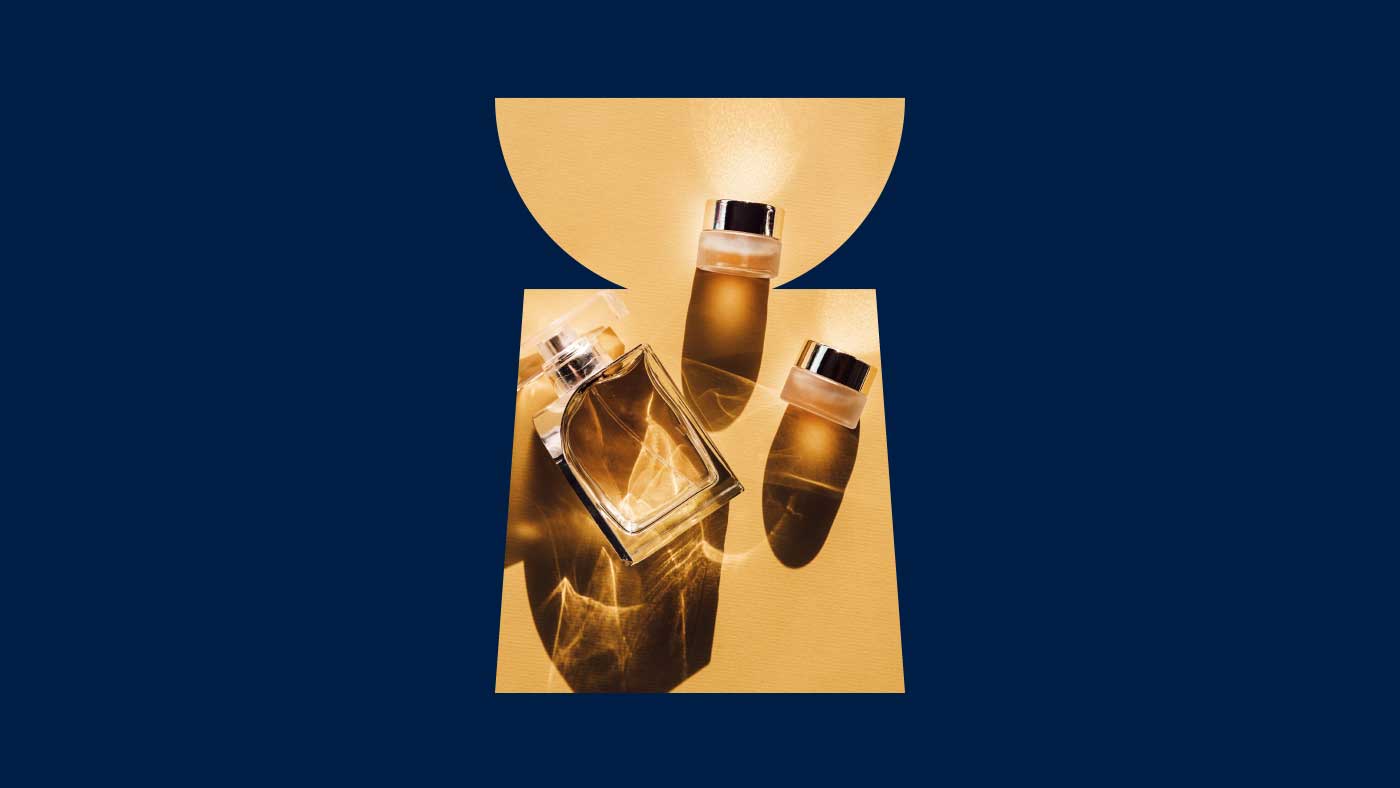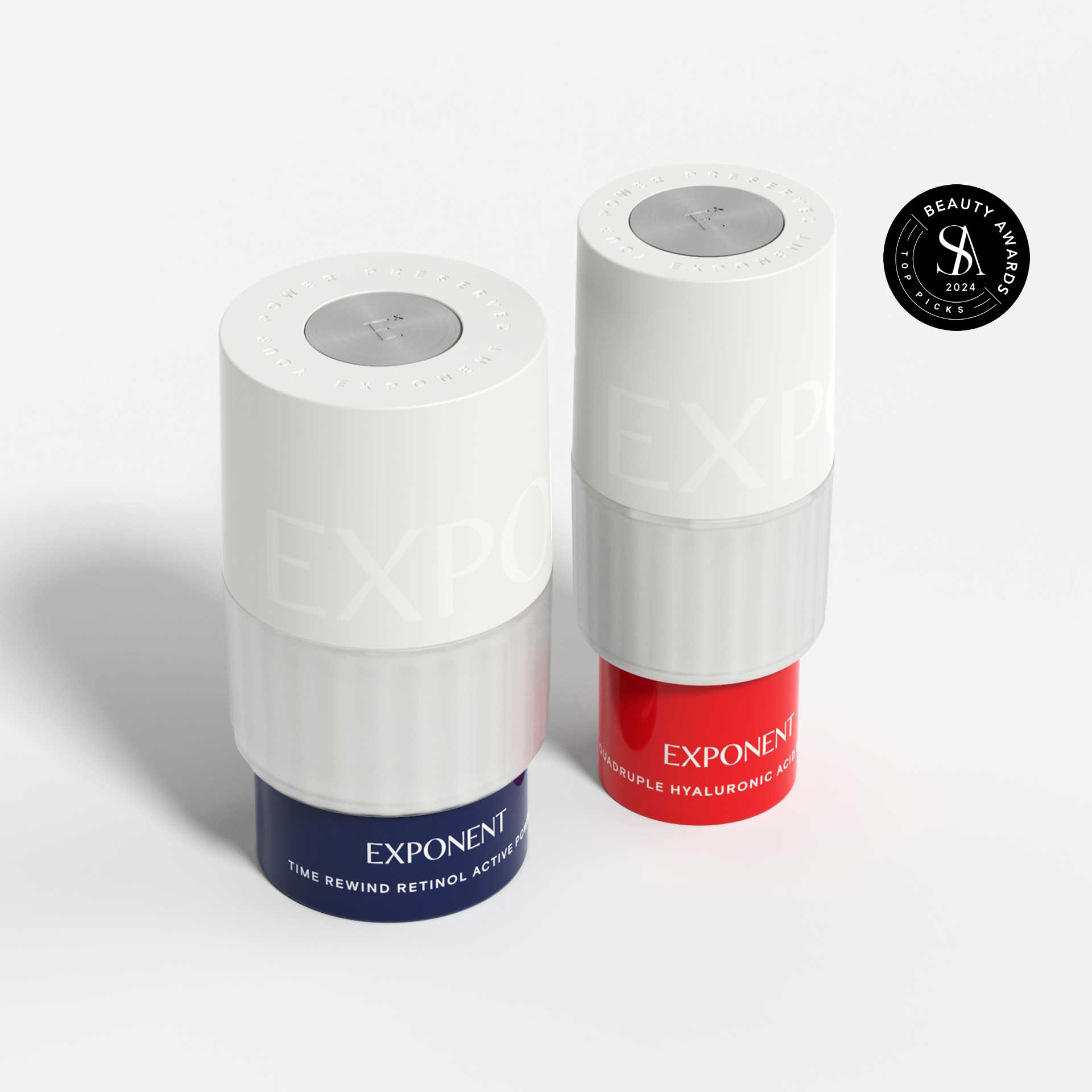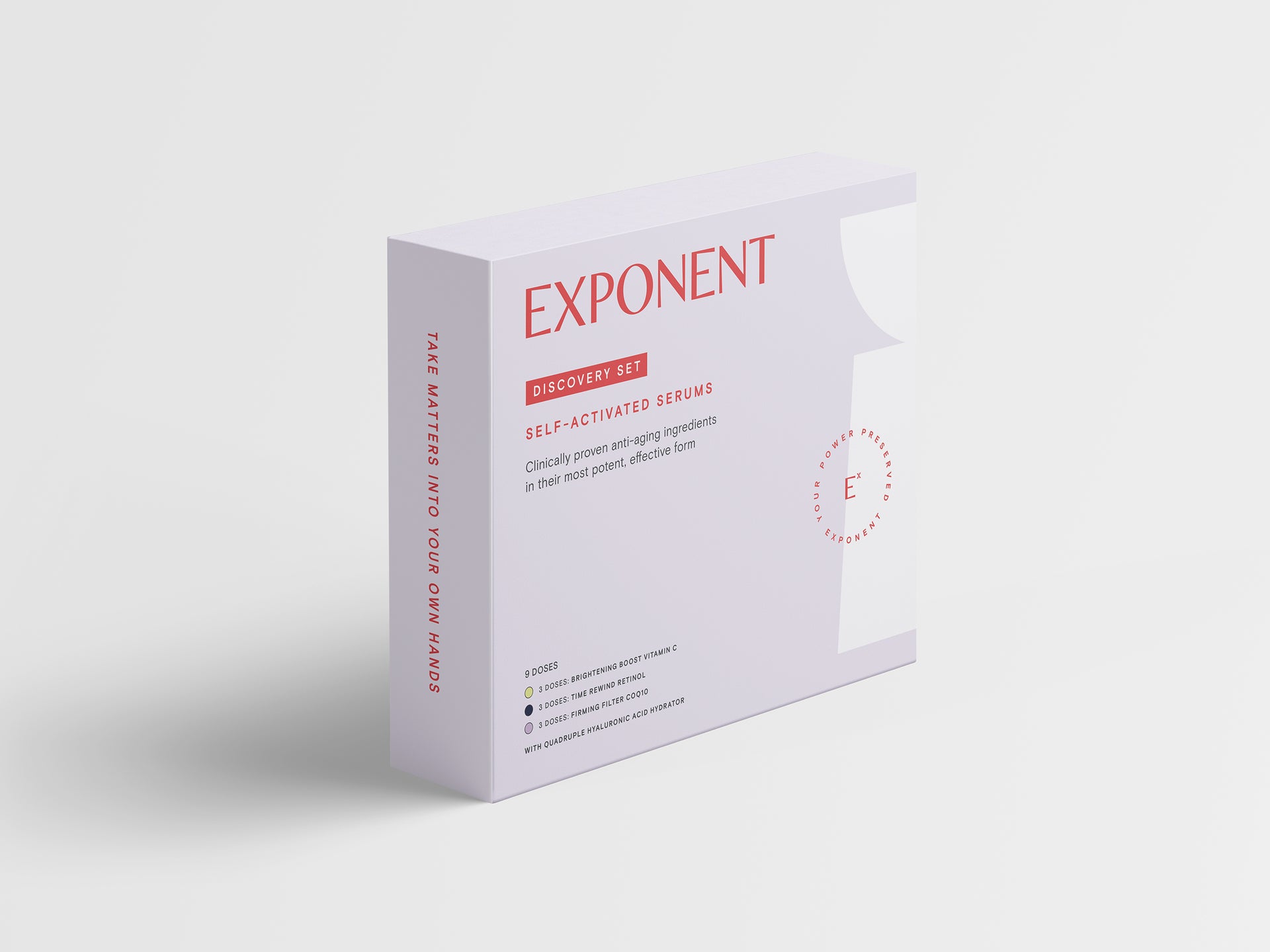For strengthening skin and erasing sun spots, retinol is the gold-standard ingredient—an "oldie but a goodie" category of skincare heroes. You've likely heard of (and used!) retinol, but have you ever heard about retinoids? Here, we're breaking down everything to know about retinol vs. retinoids. Prepare to be intrigued—and potentially surprised.
After you get your dose of knowledge, check out Exponent Beauty's Time Rewind Serum, featuring 0.25% Retinol in every dose
Retinol vs. Retinoids - What's the Difference?
Due to their similar names, many get confused about the difference between retinol and retinoids. There are distinct differences, but there is also a strong relation between them. Retinol is actually a type of retinoid, mostly used in over-the-counter (OTC) skincare products, whilst retinoid is an umbrella term used for all vitamin A derivatives, including OTC formulas and prescription-strength products.
However, even if retinoids encompass all vitamin A derivatives, the term usually refers to its more powerful counterparts, such as tretinoin, and tazarotene, which can only be purchased by prescription. As such, the main difference between retinol and retinoids is strength. Retinol is a weaker form of retinoid that works gentler and tends to be less drying, commonly used to address moderate acne, wrinkles, and uneven tone and texture. On the flip side, retinoids include prescription-strength forms of vitamin A, ideal for more severe conditions.
Is Retinoid Better than Retinol?
Retinoids are more potent than retinol since they contain a higher amount of retinoic acid (the most active form of vitamin A), but that doesn't necessarily make it better. Even if retinol and retinoids have the same purpose, retinol is gentler and takes more time to show results. For this reason, retinol is preferred by those who are willing to wait a little more for the benefits and want to offset possible drying and irritating effects often associated with retinoid use.
On the other hand, retinoids are more suitable for those who want more dramatic outcomes in less time and struggle with severe acne, wrinkles, and uneven texture. Thereby, we consider retinol the best option to prevent and tackle minimal signs of aging and breakouts and retinoids for more intense conditions.
What is Retinol?
Retinol is a type of retinoid, a derivative of vitamin A, found in plants like carrots, sweet potatoes, pumpkin, and eggs. Still, the retinol in our skincare products is mostly lab-made, mimicking the molecule found in nature. When applied to the complexion, retinol converts to retinoic acid — the most active form of vitamin A — helped by specific enzymes naturally found in the skin. Once converted, retinol benefits include accelerating cell turnover, shedding off dead cells and making room for new healthy cells to replace them. That's how you get refined, smooth texture, less visible wrinkles and dark spots, fewer breakouts, and an even tone.
According to the American Academy of Dermatology, retinol is found in concentrations of up to 2% in OTC skincare products.1 If you're looking for more potent retinoids, you need a prescription.
What is a Retinoid?
Retinoid is a generic term for all the compounds derived from vitamin A. While OTC forms include retinol and retinal, retinoids usually refer to the prescription-strength derivatives intended for more severe aging signs and acne conditions. Retinoids can be naturally synthesized from beta-carotene and synthetically lab-made, mimicking the natural form.
Available in two forms, retinoids can be topically applied and taken orally, both working to accelerate skin renewal, rev collagen, and reduce the look of aging signs, uneven texture, and breakouts.
Benefits of Retinoids
The benefits of retinoids circle around their potency to soften fine lines and wrinkles, treat acne and minimize hyperpigmentation. Retinoids mitigate wrinkles by replacing old cells with new, smoother ones and also because they induce collagen and hyaluronic acid production, leaving skin moist and plump when used in the long run.
As powerful keratolytic, retinoids break down the outer skin layer, peeling and shedding it, which helps diminish acne and unclog pores. Also, retinoids are anti-inflammatory and comedolytic, targeting inflamed pimples and lessening their appearance. Other benefits of retinoids include minimizing dark spots, softening rough patches, and unclogging congested pores.2
Here are the benefits of retinoids:
- Increase collagen production
- Unclog pores
- Speed up cell turnover, softening skin
- Slow down aging caused by UV exposure
- Reduce inflammation
How to Apply Retinoids
Because retinoids usually include the more potent forms of vitamin A, they can often lead to skin sensitivities and irritation, so knowing how to use them is a priority. When incorporating retinoids into your routine, you should consider how tolerant your skin is and your skin tone as well.
In case you have a light skin tone, you should start off your retinoid use by applying the product every third night. Supposing your complexion can tolerate it in the first two weeks, you can work your way up to every other night and observe how your skin reacts. If handled, you can go for nightly use of retinoid.
For medium and dark tones, it's best to start slowly to avoid redness and irritation that can lead to post-inflammatory hyperpigmentation. We recommend you use your retinoid product once weekly to help your skin adjust to it and gradually increase to two-three uses a week.
This is how you apply retinoids:
- Cleanser: Wash away makeup, sunscreen, and impurities
- Toner: Use a toner to energize skin and remove traces of debris
- Retinol: Apply retinoid serum cautiously, avoiding the eye area
- Moisturizer: Apply a fragrance-free facial moisturizer to lock everything in
When to Apply Retinoids
The best time to apply retinoids is at night since the sun breaks them down, rendering them less effective. At the same time, retinoids make skin extra sensitive to the sun, increasing the risk of sun damage such as premature wrinkles and dark spots.
Can I Use a Retinoid Everyday?
Retinoids provide the best benefits when used daily. However, if you're a retinoid first-timer, it's best to start slowly and not directly with everyday use. When you notice your skin can tolerate it, you can gradually increase frequency from once weekly application to once every third night, then every night.
How Often Should You Use Retinoids?
Even if retinoids give outstanding outcomes when used daily, you should start with once a week applications and observe how your skin reacts. If tolerated, increase the frequency slowly to give your skin the time to adjust to retinoids. When you observe your skin is acclimated to retinoids use, you can apply them nightly.
When Will You See the Results of Retinoids?
Depending on your skin condition and the retinoid strength, you can observe results in as little as a few weeks. If you're using retinoids for acne, the results may show faster than when used for wrinkles. Dead cells and clogged pores are eliminated after the first uses of retinoids, making acne diminish after 12 weeks of use.
As far as wrinkles are concerned, it's been revealed that 0.05% nightly tretinoin showed improvements in fine wrinkles in approximately 3 months. But if your skin can't tolerate daily use of tretinoin, you should expect results from 6 to 12 months, depending on the application frequency and retinoid concentration.3
Potential Side Effects of Retinoids?
As the skin adjusts to retinoid use, some side effects are expected, including redness, dryness, and peeling. Those with sensitive skin or struggle with conditions like rosacea or eczema are more prone to retinoid side effects, and for that reason should start low and slow. However, side effects of retinoids are anticipated even if your skin is not easily reactive because that's how retinoids work: they get rid of the old skin layer in a fast manner, causing the skin to dry and peel until it becomes accustomed to the process.
However, there are a few habits that might exacerbate the potential side effects of retinoids, among which are overusing them, applying a too high concentrated product as a retinoid beginner, wearing retinoids before sun exposure, or applying retinoids on a weakened barrier or damaged skin.
These are the most common side effects of retinoids:
- Redness
- Dryness
- Itching
- Peeling and flaking
- Photosensitivity
Recommended Retinoid Pairings
Retinoids are great on their own but even better when paired with other praised skincare actives. If known how to mix, retinoids can give more transformative benefits than using them alone, and here we teach you how to pair retinoids with other skincare powerhouses to get the best outcomes.
How to Use Retinoids with Vitamin C
Two of the most powerful skincare actives, retinoids, and vitamin C, can change your skin if used correctly. Misusing these two can lead to redness and dryness, as they work at a low pH. To avoid the potential risk of sensitivities, separate the use of vitamin C and retinoids. Apply your vitamin C product in the morning to get protection against free radicals, and leave the retinoid product for your nighttime routine to repair the skin.
Using retinoid and vitamin C together can help brighten, smooth skin, soften wrinkles and diminish photoaging.4 Vitamin C benefits imply guarding against oxidative stress, lightening dark patches, and enhancing collagen production, while retinoid renews cells, evens tone, and induces collagen. The result? Smoother skin, less visible wrinkles, and evener tone.
How to Use Retinoids with Hyaluronic Acid
It is advisable and perfectly safe to use retinoids with hyaluronic acid as they have a synergistic effect benefiting the skin in multiple ways. Pairing these skincare staples reveal plump, glowy skin with fewer chances of irritation that often come with retinoid use. Hyaluronic acid increases hydration levels and retains skin moisture, while retinoids boost collagen and hyaluronic acid in the skin, shed off dead cells, and even tone.
If your retinoid product is in a cream or gel form, layering a hyaluronic acid-infused serum beneath can help prevent dryness and peeling. Or, if you're using a retinoid serum, you should layer it first, followed by hyaluronic acid serum. Applying hyaluronic acid first might boost retinoid penetration, increasing the chances of dryness.
How to Use Retinoids with Glycolic Acid
Using retinoids and glycolic acid has outstanding benefits for acne, post-acne marks, and wrinkles if used rightly.5 This combo reveals smoother, evener, and softer skin with less visible aging signs and speeds up breakout healing when applied correctly.
However, even if retinoids and glycolic acid are great for skin, they shouldn't be used at the same time as they both work by peeling the outer skin layer. You should either use glycolic acid in the morning and retinoid at night or use them on alternative days for the best results. By doing so, you avoid over-exfoliation and unnecessary dryness and irritation, yet you receive optimal benefits.
Find the Best Retinoid or Retinol Product for You
At Exponent, our mission is to set a new standard for effective skincare so you can cut through the clutter and choose products that actually work without worrying about the daily environment deactivating them. For us, lost actives are a lost cause. So, do yourself (and skin) a favor and try our Retinol Serum. And, in case you want to give your skin a jumpstart and help protect, firm, even, and smooth it some more, pick the Brightening Boost Vitamin C Serum and pair them together to enhance their effects.
Footnotes
- American Academy of Dermatology, How to prevent premature skin aging. Source
- Zasada M, Budzisz E. Retinoids: active molecules influencing skin structure formation in cosmetic and dermatological treatments. Postepy Dermatol Alergol. 2019. Source
- Retinoids: literature review and suggested algorithm for use prior to facial resurfacing procedures. Source
- Seité S, Bredoux C, Compan D, Zucchi H, Lombard D, Medaisko C, Fourtanier A. Histological evaluation of a topically applied retinol-vitamin C combination. Skin Pharmacol Physiol. 2005 Mar-Apr. Source
- Chandrashekar BS, Ashwini KR, Vasanth V, Navale S. Retinoic acid and glycolic acid combination in the treatment of acne scars. Indian Dermatol Online J. 2015. Source






